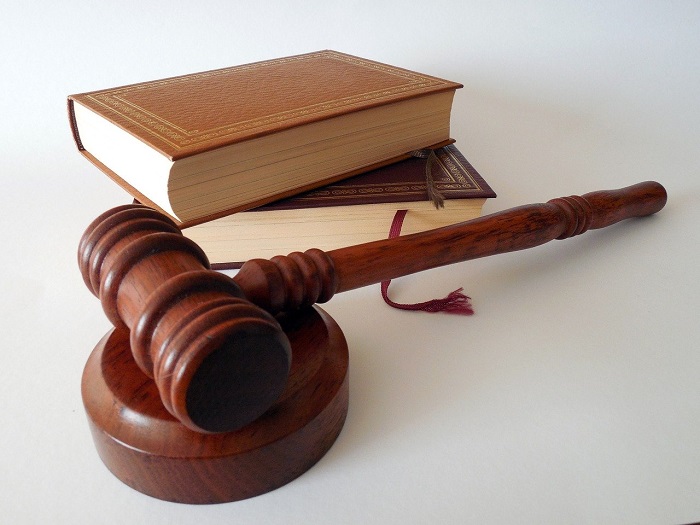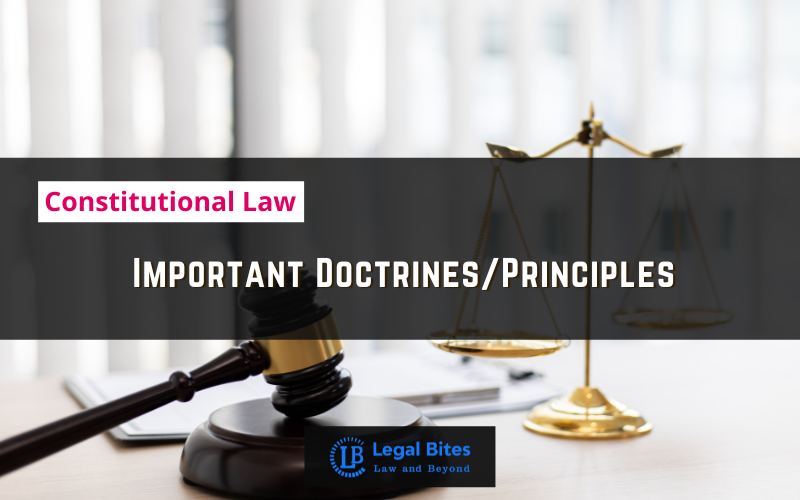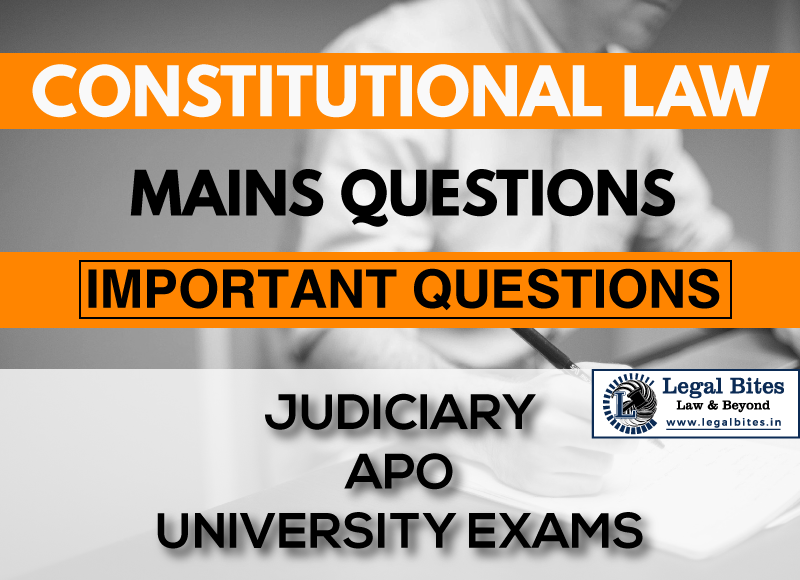High Court: Composition, Appointment, Removal, Powers & Duties
High Court: Composition, Appointment, Removal, Powers & Duties | Overview Composition of the High Court Appointment And Conditions of Service Salary and Allowances Removal of Judges in the High Court Powers and Duties of the High Court Articles 214 to 231 of the Constitution of India deal with the High Courts in India. At present, there are 25… Read More »
;
High Court: Composition, Appointment, Removal, Powers & Duties | Overview Composition of the High Court Appointment And Conditions of Service Salary and Allowances Removal of Judges in the High Court Powers and Duties of the High Court Articles 214 to 231 of the Constitution of India deal with the High Courts in India. At present, there are 25 High Courts in India with the High Court in Amravati being the latest addition to the list.[1] All High Courts are to be Courts of Record...
High Court: Composition, Appointment, Removal, Powers & Duties | Overview
- Composition of the High Court
- Appointment And Conditions of Service
- Salary and Allowances
- Removal of Judges in the High Court
- Powers and Duties of the High Court
Articles 214 to 231 of the Constitution of India deal with the High Courts in India. At present, there are 25 High Courts in India with the High Court in Amravati being the latest addition to the list.[1] All High Courts are to be Courts of Record and should have all such powers that a Court of Record must have along with the power to punish for its own contempt.[2]
In 1861, the British Parliament passed the Indian High Courts Act, 1861. This established High Courts in Calcutta, Bombay, and Madras. This Act did not create these Courts, it only provided for their fusion and the same was to happen by issuing Letter Patent.[3]
Every High Court has superintendence over all Courts and Tribunals throughout the territory of its State.[4] This implies that the High Court may make and issue general rules and prescribe forms for regulating the proceedings of these Courts. However, the High Court in a State does not have superintendence over any Court or Tribunal constituted under any law relating to the Armed Forces.[5]
In India, it is neither the State Legislature nor the State Executive that have any power over the High Courts. It is only the Parliament that can make laws with respect to the State Judiciary.
Composition of the High Court
The Constitution provides for a High Court in each state.[6] It also provides for the possibility of having one High Court for two or more states or two or more states and a union territory or a state and a union territory.[7]
Delhi is the only Union Territory that has a High Court of its own. The Madras High Court has jurisdiction over Puducherry, the Calcutta High Court has jurisdiction over Andamans and Nicobar Islands, the Punjab and Haryana High Court have jurisdiction over Chandigarh, the Bombay High Court has jurisdiction over Dadra and Nagar Haveli and the High Court of Kerala has jurisdiction over Lakshadweep islands.[8]
Every High Court shall consist of a Chief Justice and such other Judges as the President of India may, from time to time, appoint.[9] The composition of the High Court also includes the appointment of additional judges for temporary periods, not exceeding 2 years, for clearance of work in the High Court.[10]
Appointment And Conditions of Service
- The appointment of judges of a High Court happens by virtue of a consultation by the President with the Chief Justice of India, the Governor of the State, and the Chief Justice of the High Court (when the appointment is that of a judge other than the Chief Justice of a High Court).[11]
- The Chief Justice of a High Court is appointed by the President, in consultation with the Chief Justice of India and the Governor of the State.
- A judge of the High Court is to hold office until the age of 62 years.[12]
- The judges of a High Court take an oath before the Governor of the State or some person appointed by the Governor.[13] It is to be noted that while the judges are appointed and removed by the President, the oath is taken before the Governor of the State and not the President.
- To be eligible to be a judge of a High Court, the person must be a citizen of India and should either have held judicial office for 10 years in any territory in India or should have been an advocate in a High Court for 10 years.[14]
- If any question with respect to the age of the judge comes up, such question shall be decided by the President of India in consultation with the Chief Justice of India and the decision of the President shall be final.[15]
- Once someone is appointed as a Permanent Judge in a High Court, such person is restricted from pleading or acting in any Court or any authority in India except the Supreme Court and other High Courts.[16]
- When the Office of the Chief Justice of a High Court is vacant and/or such Chief Justice is unable to perform the duties of his/her office, the duties of the office shall be performed by such other judge of the High Court as the President may appoint for that purpose.[17]
- If, because of a temporary increase in the business of a High Court, the President believes that the number of the judges in the High Court should be increased, the President may appoint Additional Judges to the High Court for such period as required and specified but not exceeding 2 years.[18] In place of such judge who replaces the Chief Justice of the High Court, the President may appoint a duly qualified person to act as a judge of that Court for the time being.[19]
- The Chief Justice of a High Court for any State may at any time, with the previous consent of the President, request any person who has held the office of a Judge of that Court or any other High Court to sit and act as a Judge of the High Court for that State. Every such person so requested shall, while so sitting and acting be entitled to such allowances as the President may by Order determine and have all the jurisdiction, powers, and privileges of, but shall not otherwise be deemed to be a Judge of that High Court. No such person would be required to sit and act as a judge unless he/she consents to do so.[20]
Salary and Allowances
Salaries and Allowances to be paid to the judges of the High Court would be such that would be determined by the Parliament, by law, from time to time.[21] The legislation that governs this is the High Court Judges (Salaries and Conditions of Service) Act, 1954. The High Court and Supreme Court Judges (Salaries and Conditions of Service) Amendment Bill, 2017 was passed by the Parliament and it upgrades the salary of the Chief Justice of a High Court from Rs. 90,000 per month to Rs. 2,50,000 per month. For all other judges in the High Court, the change in the salary is a shift from Rs. 80,000 per month to Rs. 2,25,000 per month.[22]
Salaries and allowances cannot be varied to their disadvantage for a judge once he/she has been appointed.[23]
Removal of Judges in the High Court
Judges of the High Court can be removed from office by three methods:
- Resignation
- Impeachment
- Transfer
A judge may resign from his/her office by writing under his/her head to the President of India. This has been provided for under Article 217 (1) (a). A judge can also be removed from Office. Under Article 217 (1) (b), a judge of the High Court can be removed in a manner similar to the removal of a judge of the Supreme Court.
The removal of a judge of the Supreme Court can only happen if both the Houses of the Parliament support a motion of removal of such judge on the grounds of proved misbehaviour or incapacity, and pass it by not less than a three-fourths majority, and further, the President passes an order in this regard for the removal of such Judge.[24]
The procedure for removal of judges has been laid down in the Judges Inquiry Act, 1968.
- An Impeachment motion may originate in either House of the Parliament.
- To initiate proceedings, either at least 100 members from Lok Sabha should give a notice to the speaker or at least 50 members from Rajya Sabha must give notice to the Chairman in Rajya Sabha.
- After consultation with individuals who presented the notice and examination of relevant material, the Speaker or the Chairman shall decide on admitting or dismissing the notice.
- If the motion is admitted, a three-member committee shall be constituted to investigate the complaint. The committee shall comprise of (i) A judge of the Supreme Court (ii) A Chief Justice of a High Court (iii) A distinguished jurist
- This committee shall frame charges based on which the investigation shall be conducted.
- A copy of the charges shall be presented to the judge against whom the charges are being framed and he/she shall submit a defence on his/her behalf.
- Once the investigation has been completed, the committee shall submit the report to the Speaker or the Chairman, who will then lay the report before the relevant House of the Parliament. If the report does record a finding of misbehaviour and/or incapacity, the motion for removal of the judge will be taken up for consideration and debated.
- The motion for removal has to be passed by a majority of the total strength of each of the Houses and also by a two-thirds majority of members of each House who are present and voting.
- Once the motion has been adopted by both Houses following these criteria, the President shall issue an order for removal of the Judge.[25]
The transfer of a judge of the High Court would also result in the vacation of such judge’s office in the High Court. The judge can be transferred by the President to the Supreme Court or any other High Court within the territory of India.[26] On a transfer of a judge from one High Court to another High Court, judges are entitled to the compensatory allowance, as fixed by the Parliament from time to time.[27]
Powers and Duties of the High Court
I. Court of Record
High Courts are Courts of Record and they have the power to punish individuals for contempt.[28] The Court’s judgments and decided cases are recorded and can be used to reply upon. They can be the basis of decision making in subordinate courts and their authenticity is not questioned as they are the records of a High Court.
II. Law Declared By The High Court Is Binding On All Subordinate Courts
- Every High Court shall have superintendence over all subordinate courts and tribunals within the territory of the High Court’s jurisdiction.
- The High Court can make and issue rules and prescribe forms for regulating the practice and proceedings of such courts.
- The High Court can also prescribe rules by which it can be decided how the officers in such courts have to maintain books, entries, and accounts.[29]
III. Power to Issue Writs
The High Court has the power to issue writs to any person within the territory of its jurisdiction for enforcement of rights incorporated under Part III of the Constitution or for any other purpose.[30] This is also how the High Court exercises its power of judicial review. Following is a list of the writs:
- Habeas Corpus
- Quo Warranto
- Mandamus
- Prohibition
- Certiorari
IV. Power of Certification
The High Court has the power to certify whether an appeal should lie before the Supreme Court in a particular case. This has to be decided based on whether the High Court thinks there is a substantial question of law with respect to the interpretation of the Constitution in that case. The Court can do this in its own motion or based on an oral application made by the aggrieved party.[31]
V. Transfer of Cases
If the High Court is satisfied that a case pending before a subordinate court has a substantial question of law as to the interpretation of the Constitution, the determination of which is necessary for the disposal of the case, the High Court shall withdraw the case from such subordinate court and either dispose of the case itself or determine the question and return the case to the court from which it was withdrawn to be disposed of in consonance with the judgment.[32]
References
[1] Andhra Pradesh gets its own High Court in Amravati, to start functioning from Jan 1, FINANCIAL EXPRESS, available at: https://www.financialexpress.com/india-news/andhra-pradesh-gets-its-own-high-court-in-amravati-to-start-functioning-from-jan-1/1426250/
[2] Article 215, The Constitution of India,1950
[3] Larby, C. J. B. “The Centenary of the High Courts of Calcutta, Bombay and Madras.” The International and Comparative Law Quarterly 12, no. 3 (1963): 1044-048. Accessed May 4, 2020. www.jstor.org/stable/756304.
[4] Article 227(1), The Constitution of India,1950
[5] Article 227(4), The Constitution of India,1950
[6] Article 214, The Constitution of India,1950
[7] Article 231, The Constitution of India,1950
[8] Jurisdiction of the Supreme Court, SUPREME COURT OF INDIA, available at: https://main.sci.gov.in/jurisdiction
[9] Article 216, The Constitution of India,1950
[10] Article 224, The Constitution of India,1950
[11] Article 217, The Constitution of India,1950
[12] ibid
[13] Article 219, The Constitution of India,1950
[14] Article 217(2), The Constitution of India,1950
[15] Article 217(3), The Constitution of India,1950
[16] Article 220, The Constitution of India,1950
[17] Article 223, The Constitution of India,1950
[18] Article 224(1), The Constitution of India,1950
[19] Article 224(2), The Constitution of India,1950
[20] Article 224 A, The Constitution of India,1950
[21] Article 221, The Constitution of India,1950
[22] The High Court and the Supreme Court Judges (Salaries and Conditions of Service) Amendment Bill, 2017, PRSINDIA.ORG, available at: https://www.prsindia.org/billtrack/high-court-and-supreme-court-judges-salaries-and-conditions-service-amendment-bill-2017
[23] Supra note 16
[24] Article 124(4), The Constitution of India,1950
[25] Roshni Sinha, Explainer: Removal of Judges from Office, PRSINDIA.ORG, available at: https://www.prsindia.org/theprsblog/explainer-removal-judges-office
[26] Article 217(1)(c), The Constitution of India,1950
[27] Article 222, The Constitution of India,1950
[28] Article 215, The Constitution of India,1950
[29] Article 227, The Constitution of India,1950
[30] Article 226, The Constitution of India,1950
[31]Article 134A, The Constitution of India,1950
[32]Article 228, The Constitution of India,1950




